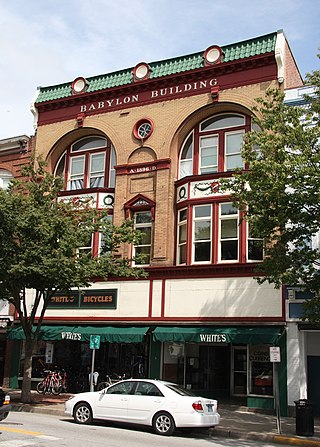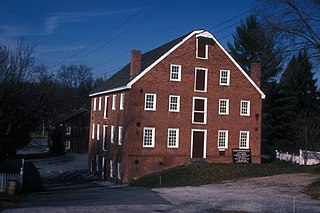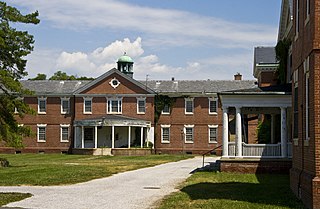
Lineboro is an unincorporated community located in northeastern Carroll County, Maryland, United States. The community was named for its founder, Jonathan Line. Coincidentally, its name refers to its location near the Mason–Dixon line.

The Sykesville Historic District encompasses the center of Sykesville, Maryland. Sykesville is a small incorporated town in the Patapsco River valley in southern Carroll County, Maryland, and is located on the old main line of the Baltimore and Ohio Railroad (B&O), one of the first railroad lines in the United States, that section dating from 1831. The B&O train station is included in the district, next to the river. It was designed by E. Francis Baldwin in the Queen Anne style and built in 1883. It is currently a restaurant having outdoor seating on the original platform. Other historically significant buildings in the district were built between the 1850s and the 1920s.

The Middletown Historic District comprises the historic center of Middletown, Maryland. Middletown became the chief community in the Middletown Valley in the late 18th century, retaining its importance until the 1930s, when the expanding influence of Frederick, Maryland, the construction of a bypass on US 40 and the abandonment of the Hagerstown and Frederick Railway produced a gradual decline. The historic district preserves many mid-19th-century buildings in the central downtown area. To the east, the district includes early 20th-century houses built along the trolley right-of-way, forming a streetcar suburb. The Airview Historic District includes a related area of early 20th century development to the east of town along the National Pike, separated from the main district by a section of newer development.

The Westminster Historic District comprises the historic center of Westminster, Maryland. The district includes about 1400 structures, with a high proportion of contributing structures. The town exhibits a variety of building styles and notable examples of Greek Revival, Georgian, and Gothic Revival style architecture. Most of the structures exhibit early 19th-century residential vernacular architecture and mid-19th century commercial architecture.

The Hyattsville Historic District is a residential neighborhood comprising a national historic district located in the city of Hyattsville, Prince George's County, Maryland. The district comprises approximately 600 structures, primarily houses, that exhibit late-19th and early-20th century design characteristics. The majority of residential buildings are of frame construction, the older ones with foundations of brick or (rarely) fieldstone, the newer of concrete. The architectural styles represented: grand "mansions," summer cottages, duplexes, Second Empire, Queen Anne, Italianate, Victorian, Bungalow, and Spanish. The area also includes numerous vernacular buildings. The finest concentration of late-19th century structures occur in the area of Farragut, Gallatin, and Hamilton streets and 42nd Avenue. The early-20th century hipped-roof style and bungalows are found throughout the district.

The Savage Mill Historic District is a national historic district located at Savage, Howard County, Maryland. The district comprises the industrial complex of Savage Mill and the village of workers' housing to the north of the complex.

The Lonaconing Historic District is a national historic district in Lonaconing, Allegany County, Maryland. It comprises 278 buildings and structures consisting of a variety of 19th and early-20th century commercial, industrial, and residential buildings. These structures identify with the development of Lonaconing as a center of the iron, coal, and silk industries in the George's Creek Valley of Western Maryland. It includes a group of 40 late-19th and early-20th century brick or frame commercial structures, including a hotel, bank, three dry goods stores, and numerous other shops and warehouses, mostly constructed after a fire which devastated downtown in 1881.

The Mount Airy Historic District is a national historic district in Mount Airy, located in Carroll and Frederick County, Maryland. The district comprises a cohesive group of commercial, residential, and ecclesiastical buildings dating from the late 19th through early 20th centuries. The brick Baltimore and Ohio Railroad station, designed by E. Francis Baldwin and constructed in 1882, represents the town's origin as an early transportation center for the region, which dates back as early as 1838. A group of early-20th century commercial structures represent the rebuilding of Mount Airy's downtown after a series of fires between 1903 and 1926. The residential areas are characterized by houses illustrating vernacular forms and popular stylistic influences of the late 19th and early 20th century. Three churches are located within the district.

The McKinstry's Mills Historic District is a national historic district in Union Bridge, located in Carroll and Frederick County, Maryland. The district comprises the entirety of the settlement of McKinstry's Mills, a 26-acre (110,000 m2) hamlet consisting of six separate properties that were owned and developed in the 19th century by the McKinstry family, local millers. At the center is a 3+1⁄2-story grist mill constructed in 1844. Also included are the McKinstry homestead, built between 1825 and 1835; the residence of miller Samuel McKinstry, dated 1849; a store building of 1850; and two other small houses and a variety of outbuildings. There is also a 1908 Warren pony truss bridge.

Carroll County Almshouse and Farm, also known as the Carroll County Farm Museum, is a historic farm complex located at Westminster, Carroll County, Maryland. It consists of a complex of 15 buildings including the main house and dependencies. The 30-room brick main house was originally designed and constructed for use as the county almshouse. It is a long, three-story, rectangular structure, nine bays wide at the first- and second-floor levels of both front and rear façades. It features a simple frame cupola sheltering a farm bell. A separate two-story brick building with 14 rooms houses the original summer kitchen, wash room, and baking room, and may have once housed farm and domestic help. Also on the property is a brick, one-story dairy with a pyramidal roof dominated by a pointed finial of exaggerated height with Victorian Gothic "icing" decorating the eaves; a large frame and dressed stone bank barn; and a blacksmith's shop, spring house, smokehouse, ice house, and numerous other sheds and dependencies all used as a part of the working farm museum activities. The original Carroll County Almshouse was founded in 1852 and the Farm Museum was established in 1965.

Granite Historic District is a national historic district in Granite, Baltimore County, Maryland, United States. It comprises the focus of a rural quarrying community located in the Patapsco Valley of western Baltimore County, Maryland. It includes two churches, a school, a social hall, former commercial buildings, and houses and outbuildings, representing the period from the initial settlement of the area about 1750 through the early 20th century, when the village achieved its present form. The district also includes the former Waltersville quarry, one of two major granite operations in the region during the period. Granite from the Waltersville and Fox Rock quarries was utilized in construction of the Baltimore & Ohio Railroad in the 1830s, and later in such projects as the Library of Congress, old Treasury Building, and parts of the inner walls of the Washington Monument in Washington, D.C., and numerous other projects in Baltimore city and county.

Silver Houses Historic District is a national historic district near Darlington, Harford County, Maryland, United States. It is a group of mid-19th century farmsteads and a church in rural east central Harford County. The district comprises a total of 36 resources, including four stone residences with related agricultural outbuildings, and the site of a fifth stone house, marked by a large frame barn, a frame tenant house, and two outbuildings. The houses were built between 1853 and 1859 by members of the Silver family. The district also includes the Deer Creek Harmony Presbyterian Church, a Gothic-influenced stone building of 1871, designed by John W. Hogg.

Linwood Historic District is a national historic district at Linwood, Carroll County, Maryland, United States. The district includes a mixture of railway structures, community structures and residences with rural dependencies. They date to the 19th and early-20th century and most structures relate to Linwood's role as a rail depot for the transportation of farm goods and supplies.

Taneytown Historic District is a national historic district at Taneytown, Carroll County, Maryland, United States. The district comprises a cohesive group of houses, churches, commercial buildings and industrial structures reflecting the development of this crossroads town from its initial platting in 1762 through the early 20th century.

Uniontown Historic District is a national historic district at Uniontown, Carroll County, Maryland, United States. The district comprises nearly the entirety of Uniontown and contains a remarkably cohesive and well-preserved collection of houses, commercial buildings, churches, and schools reflecting the development of this agricultural village from the turn of the 19th century through the 1930s. It is an example of a linear townscape typical of small settlements in rural north-central Maryland during the 19th century.

Union Mills Homestead Historic District is a national historic district at Westminster, Carroll County, Maryland, United States.

Warfield Complex, Hubner, and T Buildings is a national historic district located at Sykesville, Carroll County, Maryland, United States. It comprises the historic core of the women's facility at Springfield State Hospital, a public mental institution. It was developed over the period 1898–1939. The complex comprises 16 contributing resources unified by a consistently high level of architectural elaboration in the Georgian and Colonial Revival style.

Western Maryland College Historic District is a national historic district at Westminster, Carroll County, Maryland, United States. It is situated within the confines of the present 100-plus acre college campus of McDaniel College and comprises an area of about three acres at its southeast corner. It includes six of the college's earliest surviving buildings and structures: Alumni Hall, Carroll Hall, Levine Hall, The President's House, Little Baker Chapel, and the Ward Memorial Arch. These structures are the oldest surviving architectural links with the 19th century beginnings of the college.

Union Bridge station is a historic railway station in Union Bridge, Carroll County, Maryland. It was built in 1902 as a stop for the Western Maryland Railway. It is representative of the rural railway stations constructed during the late 19th and early 20th centuries. The station's two buildings are arranged with their south façades lengthwise fronting the railroad tracks.

South Chesapeake City Historic District is a national historic district at Chesapeake City, Cecil County, Maryland, United States. It reflects the town's period of greatest prosperity in the mid 19th century when the adjacent Chesapeake and Delaware Canal was an active commercial artery between major east coast waterways. Buildings from the 19th century dominate those few of the early 20th century and those of recent vintage.
























